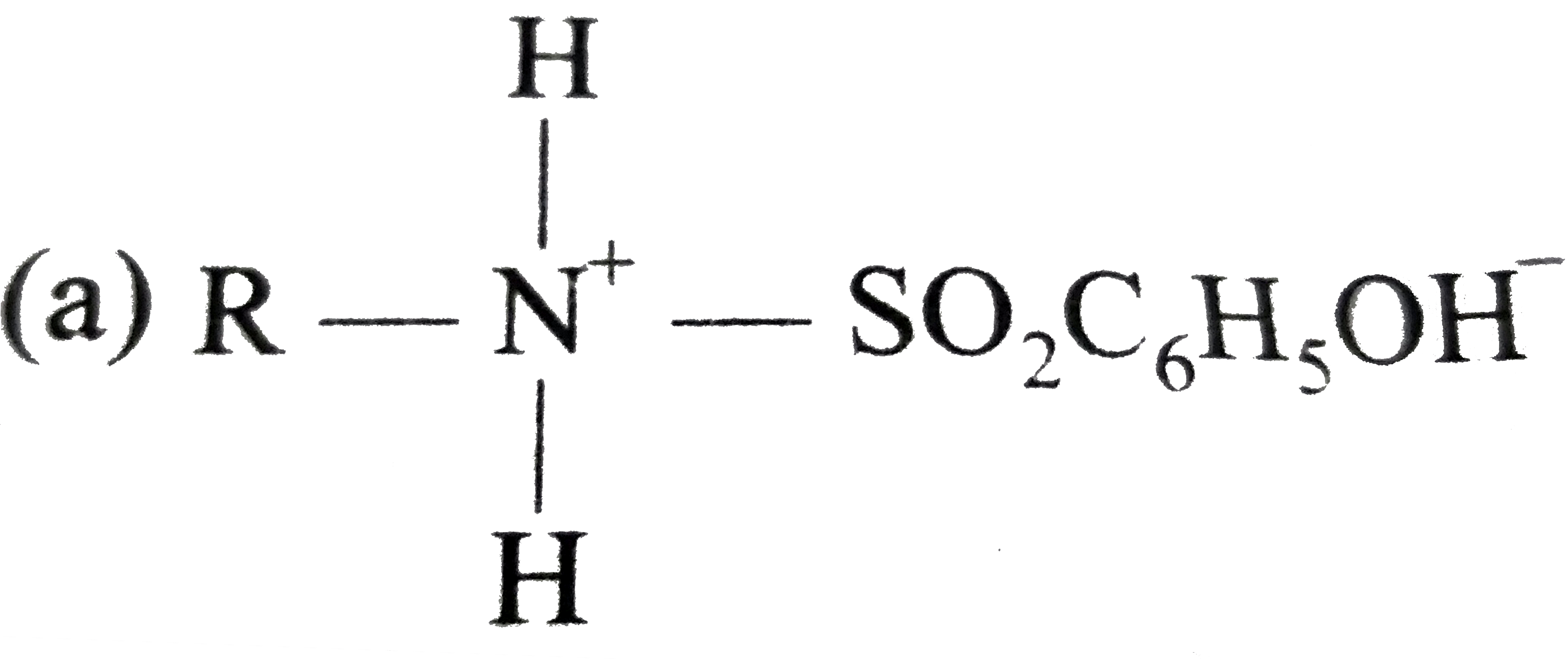RNH2 reacts with C6H5SO2Cl in aqueous KOH to give a clear solution. On acidification a precepitate is obtained which is due to the formation of

R−N−SO2C6K5K+
R−NHSO2C6H5
C6H5SO2NH2
The correct Answer is:C
To solve the problem step by step, let's analyze the reaction between the primary amine (RNH₂) and benzene sulfonyl chloride (C₆H₅SO₂Cl) in the presence of aqueous KOH, followed by acidification.
1. Identify the Reactants:
- The primary amine is represented as RNH₂.
- The reagent is benzene sulfonyl chloride, C₆H₅SO₂Cl.
2. Reaction with Aqueous KOH:
- When RNH₂ reacts with C₆H₅SO₂Cl in the presence of aqueous KOH, a reaction occurs where the amine attacks the sulfonyl chloride.
- This results in the formation of a sulfonamide (C₆H₅SO₂NHR) and hydrochloric acid (HCl) as a byproduct.
- The reaction can be summarized as:
RNH2+C6H5SO2Cl→C6H5SO2NHR+HCl
3. Formation of a Clear Solution:
- The product formed (C₆H₅SO₂NHR) is initially soluble in the aqueous KOH solution, leading to a clear solution.
4. Acidification:
- Upon acidification of the solution (adding an acid), the sulfonamide (C₆H₅SO₂NHR) precipitates out of the solution.
- This is because the sulfonamide becomes less soluble in acidic conditions.
5. Precipitate Formation:
- The precipitate obtained upon acidification is due to the formation of the sulfonamide, which is a white solid.
- The final product can be represented as:
C6H5SO2NHR(white precipitate)
6. Conclusion:
- The precipitate formed upon acidification is due to the formation of the sulfonamide (C₆H₅SO₂NHR).
Final Answer:
The precipitate obtained upon acidification is due to the formation of C₆H₅SO₂NHR (a sulfonamide).
---
- The primary amine is represented as RNH₂.
- The reagent is benzene sulfonyl chloride, C₆H₅SO₂Cl.
- When RNH₂ reacts with C₆H₅SO₂Cl in the presence of aqueous KOH, a reaction occurs where the amine attacks the sulfonyl chloride.
- This results in the formation of a sulfonamide (C₆H₅SO₂NHR) and hydrochloric acid (HCl) as a byproduct.
- The reaction can be summarized as:
RNH2+C6H5SO2Cl→C6H5SO2NHR+HCl
- The product formed (C₆H₅SO₂NHR) is initially soluble in the aqueous KOH solution, leading to a clear solution.
- Upon acidification of the solution (adding an acid), the sulfonamide (C₆H₅SO₂NHR) precipitates out of the solution.
- This is because the sulfonamide becomes less soluble in acidic conditions.
- The precipitate obtained upon acidification is due to the formation of the sulfonamide, which is a white solid.
- The final product can be represented as:
C6H5SO2NHR(white precipitate)
- The precipitate formed upon acidification is due to the formation of the sulfonamide (C₆H₅SO₂NHR).
The precipitate obtained upon acidification is due to the formation of C₆H₅SO₂NHR (a sulfonamide).
Topper's Solved these Questions
- ORGANIC COMPOUNDS CONTAINING NITROGENBOOK - A2ZCHAPTER - ORGANIC COMPOUNDS CONTAINING NITROGENEXERCISE - Aromatic Amines And Diazonium Salts
61 Videos
- ORGANIC COMPOUNDS CONTAINING NITROGENBOOK - A2ZCHAPTER - ORGANIC COMPOUNDS CONTAINING NITROGENEXERCISE - Nitrocyanide And Isocyanides
32 Videos
- ORGANIC COMPOUNDS CONTAINING HALOGENSBOOK - A2ZCHAPTER - ORGANIC COMPOUNDS CONTAINING HALOGENSEXERCISE - Section D - Chapter End Test
30 Videos
- P BLOCK ELEMENTS ( GROUP 15,16,17,18)BOOK - A2ZCHAPTER - P BLOCK ELEMENTS ( GROUP 15,16,17,18)EXERCISE - Section D - Chapter End Test
30 Videos
Similar Questions
A white substance (A) reacts with dilute H2SO4 to produce a colourless suffocating gas (B) and a colourless solution (C )/ The reaction of gas (B) with potassium iodate and starch solution produce a blue colour solution. Aqueous Solution of (A) gives a white precipitate with BaCl2 solution which is soluble in dilute HCl. Addition of aqueous NH3 or NaOH to (C ) produced first a precipitate which dissolves in excess of the respective reagent to poduced a clear solution. Similarly addition of excess of potassium ferrocyanide to (C ) produced a precipitate (D) which also dissolves in aqeous NaOH giving a clear solution. Identify (A),(B),(C ) and (D ). Write the equation of the reactions involved.
View SolutionH2SO4, reacts with PCl5 to give
View Solution
Knowledge Check
Hinsberg reagent is benzenesulfonyl chloride. In aqueous KOH this reacts with primary amine (RNH2) to give a clear solution which on acidification gives a white on acidification gives a white precipitate, which is due to the formation of
AR−NHSO2C6H5BC6H5SO2NH2CR−N−SO2C6H5K+DR−N∣N+∣H−SO2C6H5OH−The amine which reacts with p- toluenesulphonyl chloride to give a clear solution which of acidification gives insoluble compound is
AC2H5NH2B(C2H5)2NHC(C2H5)2nDCH3NHC2H5The amine, which reacts with p-toluenesulphonyl chloride to give a clear solution, which on acidification gives insoluble compound is
AC2H5NH2B(C2H5)2NHC(C2H5)3NDCH3NHC2H5
An amine reacts with C6H5SO2Cl and the product is soluble in alkali, amine is
View SolutionThe amine which reacts with p-toluenesulphonyl chloride to give a clear solution which on acidification gives insoluble compound is __________.
View SolutionPotassium dichromate acts as a strong oxidising agent in the acidic medium. When heated with a metal chloride and conc. sulphuric acid, it gives orange red fumes. On passing these fumes through sodium hydroxide, it gives a yellow solution (X) and this acidified solution gives yellow precipitate (Y) with lead acetate. On heating potassium dichromate with KOH, it forms a yellow solution (Z) which on acidification changes to orange colour. Acidified solution of dichromate ion gives deep blue colour with H2O2 due to the formation of (P)
The orange red fumes obtained on heating potassium dichromate with a metal chloride and conc. H2SO4 is due to the formation of
View SolutionAmmonia reacts with K2[HgI4]in the presence of KOHsolution to give a
View SolutionBenzil, C6H5COCOC6H5, on heating with aqueous KOH and subsequent acidification gives
View Solution
